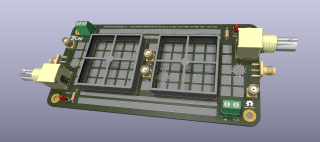My new radio node that I designed last month is back from production at jlcpcb. Designed in Romania and built in China 😁. This is my first attempt using jlcpcb for the entire manufacturing chain, from PCB creation to part selection and assembly. It was a very pleasant experience, the quality of the boards is extremely good:
I was not entirely sure that I nailed how CM108 works so my initial lot is small, only five pieces.

The radio node mounted on a standard 20-pin header of a Raspberry Pi 4B+. It can be used equally on larger RPis on on RPi Zero W. The double red-black wire in picture connects D+/D- CM108 data pair with the corresponding USB 2.0 pins on the other side of the Raspberry Pi board. It is recommended to have these wires through a small ferrite, to block unwanted RF. The assembly quality is very good. I chose on purpose very small SMDs (0402/1005 metric) to test the quality and JLCPCBs capabilities.
However, it works very well, the only glitch is that the squelch LED does not light up when I press by handheld’s PTT. Seems that the GPIO should be controlled by a dedicated software. Next version will have a slightly modified hardware design but, before I will try to fix this issue modifying the schematic, I will try to control it via software.
The project is based on svxlink and CM108 for audio. CM108 is a highly integrated single chip USB audio solution. It includes a dual DAC and headphone amplifier, ADC, microphone booster, PLL, crystal-less design, regulator, anti-pop circuitry and USB transceiver. The chip is connected in parallel to Raspberry Pi’s USB D+ and D- ports. Once the correct connection is done, you can test it with lsusb:
tom@rpi-yo3iti:~ $ lsusb Bus 002 Device 001: ID 1d6b:0003 Linux Foundation 3.0 root hub Bus 001 Device 003: ID 0d8c:0012 C-Media Electronics, Inc. USB Audio Device Bus 001 Device 002: ID 2109:3431 VIA Labs, Inc. Hub Bus 001 Device 001: ID 1d6b:0002 Linux Foundation 2.0 root hub
The svxlink.conf should be modified to support HIDRAW-based configuration. I will publish the details in a separate article.
For now, I am using this node for my daily ham radio hobby and seems to work just fine. I finally have something that looks nice and works well. Modulation is perfect and there are no noises or other artifacts. At least when powering it from batteries. With switch mode supplies, the transmission is quite noisy, depending how good are the power source output filters. I am strongly considering completely modifying the design to power RPi via the hat. This way I can design some good filters that should clean up the audio. Probably in a future project 😜.
73























